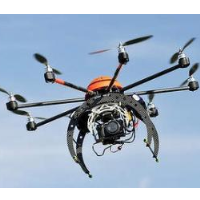Fed’s Hollywood Exemption Opens the Door for Commercial Use of Drones

The Federal Aviation Administration (FAA) waived its 2007 ban on commercial use of drones Thursday to allow six filmmaking companies to send cameras airborne on vehicles that have not been certified for flight.
Secretary of Transportation Anthony R. Foxx made it clear it won’t be the last waiver granted. “Today’s announcement is a significant milestone in broadening commercial use,” he said in a conference call attended by the New York Times. The government gave British Petroleum the first commercial drone authorization in June to fly surveillance of pipelines, roads and equipment at its Prudhoe Bay field in Alaska, but has been stingy since.
Former Connecticut Democratic Senator and current Motion Picture Association of America (MPAA) Chairman Chris Dodd praised the FAA decision as expanding uses of cinematic art to deliver finer entertainment to the public. “Our industry has a history of successfully using this innovative technology overseas—making movies like “Skyfall” and “Transformers: Age Of Extinction,” to name a couple—and we are proud to now be on the leading edge of its safe commercial use here at home.”
The six approved film companies are Aerial Mob, Astraeus Aerial, HeliVideo Productions, Pictorvision, Snaproll Media and Vortex Aerial.
Forty other Hollywood companies are said to have submitted applications, but theirs is certainly not the only industry anxious to deploy drones. Amazon got big play on CBS’s “60 Minutes Overtime” last December when CEO Jeff Bezos made a pitch for half-hour delivery of his products using drones.
Politico reported that Warren Buffet’s BNSF Railway Co. applied for an exemption (to monitor its operations) and Yamaha Motors wants one for its RMAX agricultural drone. Back in March, Boston.com noted a “burgeoning commercial market” poised for explosion and listed seven potential uses of drones:
Delivery: Domino’s delivery guys may be an endangered species
Internet: Moveable wireless access points that can hover in the air for years?
News: Why put big, expensive, manned whirlybirds in the sky when you can swarm a news site with cheap little ones?
Photography: Can a drone take a selfie? There are myriad potential commercial uses of aerial photography, including sports. Sign stealing in baseball could be taken to a new level.
Agriculture: Drones could host monitors other than cameras to check large farms for disease, critters and environmental challenges.
Population growth: Not humans. The law will surely protect the privacy of humans from spies in the sky. But animals are fair game, and they could be surveyed for scientific reasons by government and academia.
Public service: This seems to be a less provocative way of noting one market that is salivating at the opportunity to widely deploy drones: law enforcement. It is sold as a boon for search-and-rescue and other humanitarian endeavors, but civil libertarians fear surveillance uses like crowd-control pose a threat that has not yet been adequately addressed in public debate.
The ban on drones to date was meant to allow time for that discussion. The FAA has not resolved issues of air safety, and the debate over police surveillance has only grown more complicated by new technology that allows the storage of images, analysis of data (like facial recognition) and coordination of limitless databases containing a wide-range of sensitive information.
While many investors, developers and other interested parties have sought permission to use drones, the entertainment industry pretty much got the nod first. Who can say no to Cirque du Soleil?
–Ken Broder
To Learn More:
Drone Exemptions for Hollywood Pave the Way for Widespread Use (by Brooks Barnes, New York Times)
FAA Approves Drone Use for Hollywood Productions, Sets Guidelines—Update (by David Robb, Deadline Hollywood)
FAA Gives Drone Exemption to Hollywood Production Firms (by Richard Verrier, Los Angeles Times)
Lights, Cameras, Drones (by Kathryn A. Wolfe, Politico)
Biggest U.S. Market for Drones May Be . . . Farmers (by Noel Brinkerhoff, AllGov)
- Top Stories
- Controversies
- Where is the Money Going?
- California and the Nation
- Appointments and Resignations
- Unusual News
- Latest News
- California Forbids U.S. Immigration Agents from Pretending to be Police
- California Lawmakers Urged to Strip “Self-Dealing” Tax Board of Its Duties
- Big Oil’s Grip on California
- Santa Cruz Police See Homeland Security Betrayal in Use of Gang Roundup as Cover for Immigration Raid
- Oil Companies Face Deadline to Stop Polluting California Groundwater





